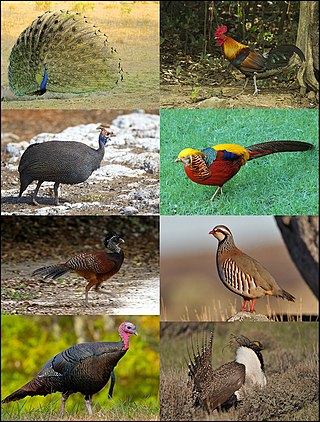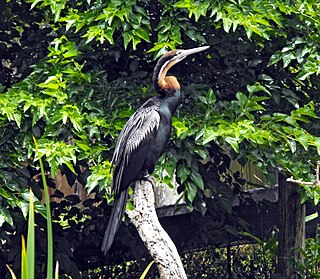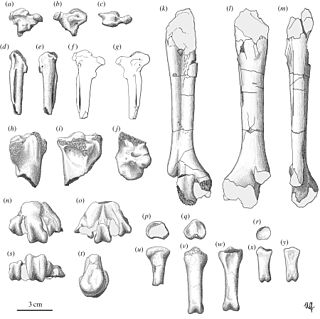
Galliformes is an order of heavy-bodied ground-feeding birds that includes turkeys, chickens, quail, and other landfowl. Gallinaceous birds, as they are called, are important in their ecosystems as seed dispersers and predators, and are often reared by humans for their meat and eggs, or hunted as game birds.

The darters, anhingas, or snakebirds are mainly tropical waterbirds in the family Anhingidae, which contains a single genus, Anhinga. There are four living species, three of which are very common and widespread while the fourth is rarer and classified as near-threatened by the IUCN. The term snakebird is usually used without any additions to signify whichever of the completely allopatric species occurs in any one region. It refers to their long thin neck, which has a snake-like appearance when they swim with their bodies submerged, or when mated pairs twist it during their bonding displays. "Darter" is used with a geographical term when referring to particular species. It alludes to their manner of procuring food, as they impale fishes with their thin, pointed beak. The American darter is more commonly known as the anhinga. It is sometimes called "water turkey" in the southern United States; though the anhinga is quite unrelated to the wild turkey, they are both large, blackish birds with long tails that are sometimes hunted for food.

The Coraciiformes are a group of usually colourful birds including the kingfishers, the bee-eaters, the rollers, the motmots, and the todies. They generally have syndactyly, with three forward-pointing toes, though in many kingfishers one of these is missing. The members of this order are linked by their “slamming” behaviour, thrashing their prey onto surfaces to disarm or incapacitate them.

The Phasianidae are a family of heavy, ground-living birds, which includes pheasants, partridges, junglefowl, chickens, turkeys, Old World quail, and peafowl. The family includes many of the most popular gamebirds. The family is a large one and includes 185 species divided into 54 genera. It was formerly broken up into two subfamilies, the Phasianinae and the Perdicinae. However, this treatment is now known to be paraphyletic and polyphyletic, respectively, and more recent evidence supports breaking it up into two subfamilies: Rollulinae and Phasianinae, with the latter containing multiple tribes within two clades. The New World quail (Odontophoridae) and guineafowl (Numididae) were formerly sometimes included in this family, but are now typically placed in families of their own; conversely, grouse and turkeys, formerly often treated as distinct families, are now known to be deeply nested within Phasianidae, so they are now included in the present family.

The mousebirds are birds in the order Coliiformes. They are the sister group to the clade Eucavitaves, which includes the Leptosomiformes, Trogoniformes (trogons), Bucerotiformes, Piciformes and Coraciformes. This group is now confined to sub-Saharan Africa, and it is the only bird order confined entirely to that continent, with the possible exception of turacos which are considered by some as the distinct order Musophagiformes, and the cuckoo roller, which is the only member of the order Leptosomiformes, and which is found in Madagascar but not mainland Africa. Mousebirds had a wider range in the Paleogene, with a widespread distribution in Europe and North America during the Paleocene.

The ground rollers are a small family of non-migratory near-passerine birds restricted to Madagascar. They are related to the kingfishers, bee-eaters and rollers. They most resemble the latter group, and are sometimes considered a sub-family of the true rollers.

Opisthocomidae is a family of birds, the only named family within the order Opisthocomiformes. The only living representative is the hoatzin which lives in the Amazon and the Orinoco delta in South America. Several fossil species have been identified, including one from Africa and one from Europe.

Sagittariidae is a family of raptor with one living species—the secretarybird native to Africa—and a few fossil taxa.

Pavo is a genus of two species in the pheasant family. The two species, along with the Congo peafowl, are known as peafowl.

Sylviornis is an extinct genus of large, flightless bird that was endemic to the islands of New Caledonia in the Western Pacific. It is considered to constitute one of two genera in the extinct family Sylviornithidae, alongside Megavitiornis from Fiji, which are related to the Galliformes, the group containing the turkeys, chickens, quails and pheasants. Sylviornis was never encountered alive by scientists, but it is known from many thousands of subfossil bones found in deposits, some of them from the Holocene, on New Caledonia and the adjacent Île des Pins. It was likely hunted to extinction shortly after the first human arrival to New Caledonia around 1500 BC.
Paleontology or palaeontology is the study of prehistoric life forms on Earth through the examination of plant and animal fossils. This includes the study of body fossils, tracks (ichnites), burrows, cast-off parts, fossilised feces (coprolites), palynomorphs and chemical residues. Because humans have encountered fossils for millennia, paleontology has a long history both before and after becoming formalized as a science. This article records significant discoveries and events related to paleontology that occurred or were published in the year 1991.
Paleontology or palaeontology is the study of prehistoric life forms on Earth through the examination of plant and animal fossils. This includes the study of body fossils, tracks (ichnites), burrows, cast-off parts, fossilised feces (coprolites), palynomorphs and chemical residues. Because humans have encountered fossils for millennia, paleontology has a long history both before and after becoming formalized as a science. This article records significant discoveries and events related to paleontology that occurred or were published in the year 1993.
Namibiavis is an extinct genus of early hoatzin from early Middle Miocene deposits of Namibia. It was collected from Arrisdrift, southern Namibia. It was first named by Cécile Mourer-Chauviré in 2003 and the type species is Namibiavis senutae.
Linquornis is a genus of peacock-sized Galliform bird that lived in Miocene of China; it consists one single species. Linquornis gigantis is the biggest bird fossil found in China.

Garganornis is an extinct genus of enormous flightless anatid waterfowl from the Late Miocene of Gargano, Italy. The genus contains one species, G. ballmanni, named by Meijer in 2014. Its enormous size is thought to have been an adaptation to living in exposed, open areas with no terrestrial predators, and as a deterrent to the indigenous aerial predators like the eagle Garganoaetus and the giant barn owl Tyto gigantea.

Panraogallus is an extinct genus of phasianid bird from the Late Miocene of what is now China. The holotype specimen was discovered in the Liushu Formation near the Zhuangkeji Township in Guanghe County, Gansu Province. The specimen consists of an almost complete skeleton of a young adult, though part of the skull and the neck vertebrae were reconstructed in plaster before the specimen was acquired by the Hezheng Paleozoological Museum. The specimen also preserves an elongated, coiled trachea, the oldest known bird fossil with such a structure. The specimen was made the basis of the new genus and species Panraogallus hezhengensis by the Chinese palaeontologist Zhihen Li and colleagues in 2018. The generic name is the pinyin of the Chinese characters for "coiling" and Latin for "chicken", which refers to the elongated trachea; "coiled chicken" in full. The specific name refers to the Hezheng area, where abundant specimens of this bird have been found.

Cécile Mourer-Chauviré is a French paleontologist specializing in birds of the Eocene and the Oligocene. In her early career, she discovered with her husband the Laang Spean cave site of prehistoric humans in Cambodia.

Afrocygnus is an extinct genus of swan, which lived during the Late Miocene, and perhaps up to the Late Pliocene, in what is today North Africa. The only genus of swan known in Africa, aside from fragmentary Pleistocene remains found in East Africa and from occasional observations of vagrant European swans along the Mediterranean coast, it lived in what was during the Miocene a damp wetland spanning from Libya to Chad, alongside the Antracothere Libycosaurus and the early Homininae Sahelanthropus. The genus is considered as the sister taxon of the extant genus Cygnus. Fossils of the genus have been uncovered in the Sahabi Formation of Cyrenaica in Libya, and in the Toros-Menalla locality in the Djurab Desert of Northern Chad.
Centuriavis is an extinct genus of phasianid landfowl from the Miocene of Nebraska. Known from a well preserved and articulated skeleton preserving the skull as well as much of the vertebral column, its name stems from the fact that it remained undescribed for nearly a hundred years. It is estimated that it weighed 1.7 kg (3.7 lb), which would make it comparable in size with the average female greater sage grouse. Centuriavis may be related to grouse and turkeys and only a single species has been described: Centuriavis lioae.


















